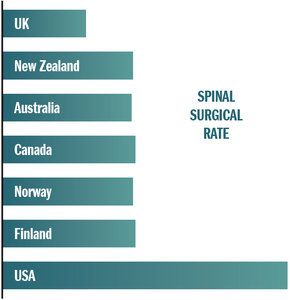New York's highest court of appeals has held that no-fault insurers cannot deny no-fault benefits where they unilaterally determine that a provider has committed misconduct based upon alleged fraudulent conduct. The Court held that this authority belongs solely to state regulators, specifically New York's Board of Regents, which oversees professional licensing and discipline. This follows a similar recent ruling in Florida reported in this publication.
Surgery: The Ultimate Placebo
A patient tells you his father has had low back pain for several years and has tried many treatments, but nothing has helped. Spinal fusion has been recommended. Complicating matters, his father lives on the other side of the country. How do you respond? What does the current research demonstrate?
Obviously, you want to get his father into the hands of a competent chiropractor who can do a comprehensive case history and examination, and determine whether he can be helped with chiropractic treatment. To facilitate this process, you want to provide your patient with some relevant research. Fortunately, a recently published resource addresses this type of surgery, among others.
What an Orthopedic Surgeon Says About Spinal Surgery

The book is "Surgery, The Ultimate Placebo" by Dr. Ian Harris1 – not only a practicing orthopedic surgeon, but also a professor of orthopedic surgery. He is a widely published research scientist and expert on spinal fusion. The book is well-researched and written in a very approachable manner. Here's what Dr. Harris says about spinal surgery:
- "[T]here is very little evidence that spine fusion surgery for back pain is effective. It is very expensive, often leads to complications, often requires further surgery, is associated with increased mortality, and often does not even result in the spine being fused."
- "Millions of people have had spine fusions for back pain, and I am not at all convinced that the benefits of this surgery outweigh the considerable harms."
- "Somebody is winning here, and it isn't the patients."
This information is important not only for this patient's father, but also your entire practice. (You might consider having a copy of the book in your reception room, with pertinent pages marked for easy reference.)
Spine Surgery: Important Facts to Understand and Share With Patients
In addition to Dr. Harris's book, you can also provide some additional facts about spinal surgery. (See the "Spinal Surgical Rate" chart.) The U.S. has the highest rate of cervical and lumbar spine surgery in the world – roughly 200 percent that of New Zealand, Australia, Canada, Norway and Finland, and 340 percent of that of the U.K.

You might assume that Americans must have higher rates of spinal pain or more severe conditions, but you would be wrong. There are no biological differences from country to country, and epidemiological studies demonstrate that rates of neck and back pain are similar among geographic areas. Could surgeon profits be the underlying cause of excessive surgeries?
Serious adverse events caused by spinal surgery are remarkably common. Several published studies conducted by independent medical research teams found that the reoperation rate (failure rate) for spinal surgery is greater than 22 percent.2 Serious postoperative pain and disability can be experienced by more than 29 percent of patients.3-4 Death rates following spinal surgery are about 1 per 1,000 operations, and blindness following spinal surgery is estimated at more than 1 per 1,000 operations.5-7
Can you imagine if chiropractors had death rates at 1 per 1,000 patients? Keep in mind, both professions do not treat dissimilar patient populations.
Spinal surgeons have failed to demonstrate benefit for spinal surgery related to disc degeneration, disc herniation, or neck or back pain. To date, spinal surgeons have failed to provide scientific evidence of surgical effectiveness sufficiently large to meet the FDA threshold for clinically meaningful benefit.
Author's Note: The research presented in this article is also available in video format by clicking here or going to the Video Archives here.
References
- Harris I. Surgery, The Ultimate Placebo: A Surgeon Cuts Through the Evidence. University of New South Wales Press, 2016.
- Kim CH, et al. The long-term reoperation rate following surgery for lumbar herniated intervertebral disc disease: a nationwide sample cohort study with a 10-year follow-up. Spine, 2019;44:1382-1389.
- Ohnmeiss DD, et al. Effect of adverse events on low back surgery outcome: twenty-four-month follow-up results from a Food And Drug Administration investigational device exemption trial. Spine, 2010;35:835-8.
- Pieber K, et al. Predictors of an unfavorable outcome 1.5 and 12 years after a first, uncomplicated lumbar disc surgery. Eur Spine J, 2016;25:3520-3527.
- Myers MA, et al. Visual loss as a complication of spine surgery. A review of 37 cases. Spine, 1997;22:1312-1319.
- Roth S, Barach P. Postoperative visual loss. Still no answers - yet. Editorial views. Anesthesiology, 2001;95:575-577.
- Wang MC, et al. Complications and mortality associated with cervical spine surgery for degenerative disease in the United States. Spine, 2007;32:342-7.



